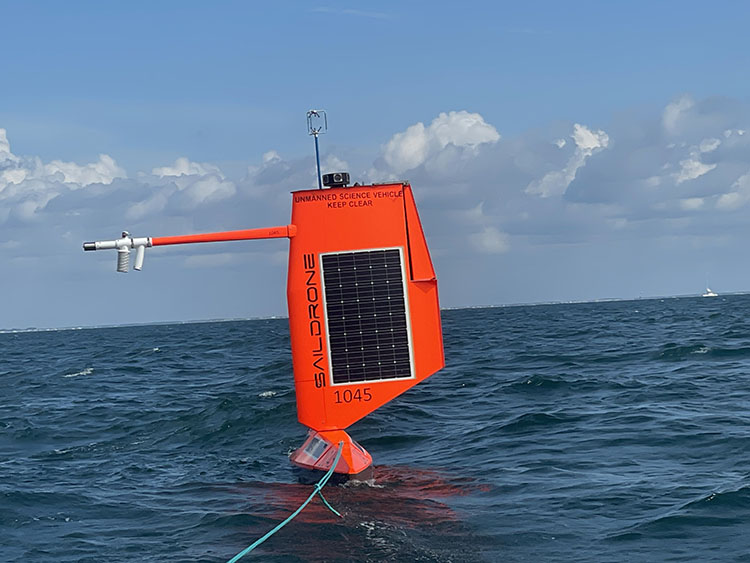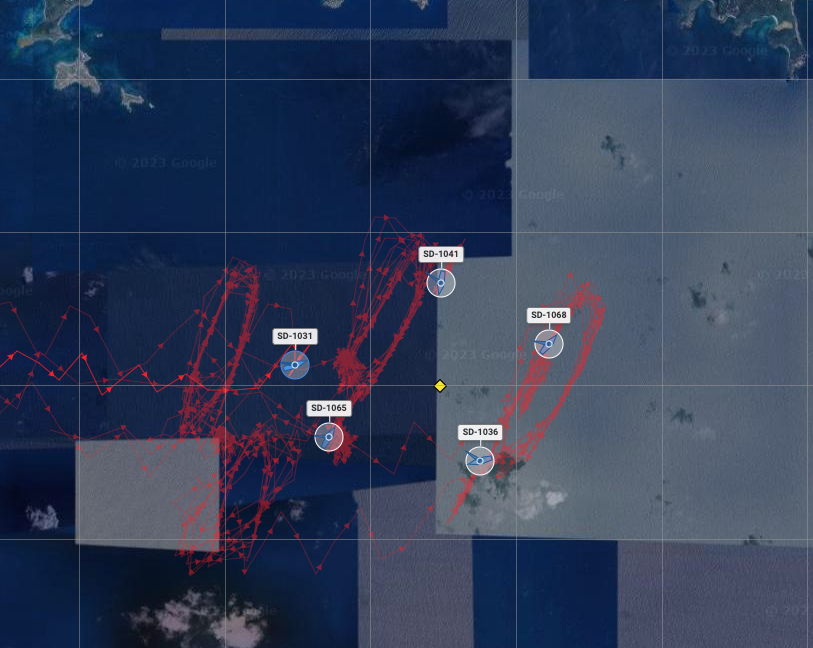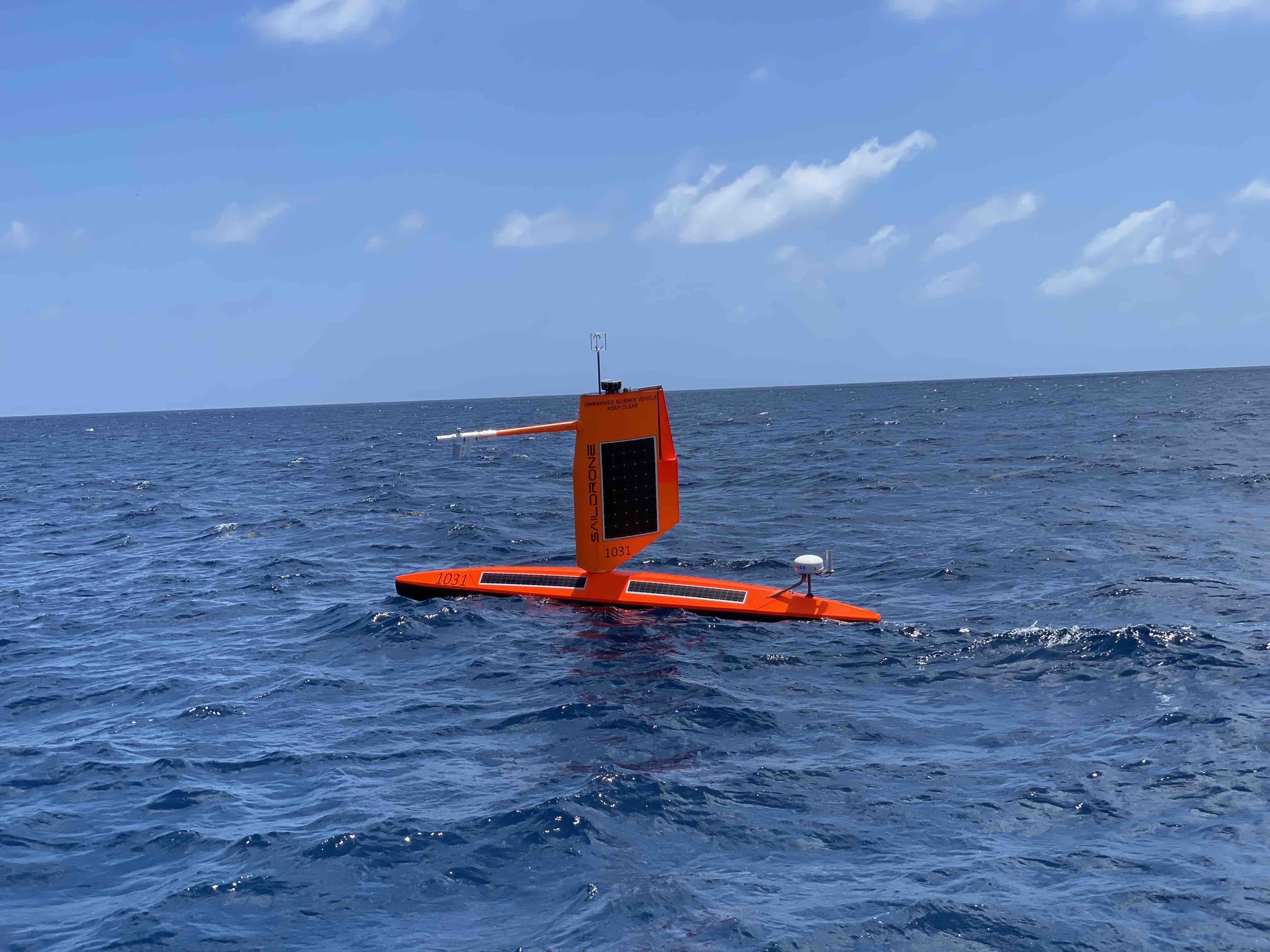NOAA-Saildrone 2023
Hurricane Mission Blog
November 16, 2023
The mission is completed today. During the mission, 6 tropical cyclones were intercepted 19 times by 10 different saildrones that measured at least sustained tropical storm-force winds of 34 kt, with the measured maximum sustained wind of 70 kt and maximum gust of 92 kt.
Combined, the saildrones traveled more than 35,000 nm (65,000 km) during August-October, spent over 140 hours (6 days) measuring sustained tropical storm wind conditions, 17 min under sustained hurricane wind conditions, 12 days with tropical storm gust winds, and 17 hours with hurricane gust winds.
The saildrones made many measurements nearly collocated with other observing platforms. The NOAA craft flew over saildrones 12 times (10 hours within 50 km). NOAA and Air Force aircraft launched 23 dropsondes that splashed within 50 km (the closest being 4.6 km) from saildrones. Saildrones spent a total of 224 days within 50 nm from NDBC buoys (93 days within 10 km). Ten saildrones were paired up with 22 underwater gliders 39 times, during which the underwater gliders made more than 10,000 profile measurements within 100 km from the saildrones. There were also 54 ARGO profiles within 100 km of saildrones. Saildrones also co-located with wave-drifters (SOFAR floats) with well over 30 days of co-location within 50 km. Saildrones also provided satellite (SAR) validation data 35 times.
The first ever coordination between a saildrone and a small uncrewed aerial system (sUAS) launched from a NOAA hurricane aircraft flight took place in a hurricane eye and eyewall of Hurricane Tammy (see video posted on October 25, 2023).
Saildrone wind, pressure, wave height, and ocean temperature data were cited in 20 different NHC operational forecast and advisory products.
October 25, 2023
A multi-saildrone mission into Hurricane Tammy was successfully completed this week. Three saildrones (SD-1040, SD-1041, SD-1068) were remotely piloted within 80 km of the storm center. In a 72-hour period, the saildrones measured maximum wind gusts of 65.6 kt, 72.3 kt and 61.5 kt, respectively. The strongest maximum sustained wind was recorded by SD-1041 at 53.7 kt along with a maximum significant wave height of 6.9 m. Earlier in the week, a fourth saildrone SD-1069, measured the environment around Tammy as the disturbance intensified from Tropical Storm to Hurricane. The animation below shows a satellite infrared loop of Tammy and color-coded tracks of the saildrones (left panel) along with the corresponding time series of surface pressure, sea surface temperature, sustained wind speed, and significant wave height (top to bottom, right panels).
September 22, 2023
Two saildrones (SD105 and 1045) observed Tropical Storm Ophelia right before she became a hurricane. They measured maximum wind gust speed 57.6 knots 106.7 km/hr), maximum sustained winds 43.1 knots (79.8 km/hr), maximum significant wave height 8.5 m (maximum wave height 15.1 m).
September 15, 2023
During the past week, hurricane Lee was observed by six saildrones, four of which sailed very close to its eye. The shortest distance was reached by saildrone 1064, which was within 49.5 km from the center of Lee. These saildrones observed the maximum gust wind speed of 92.4 knots (171 km/hr), maximum wave height of 24.7 m (maximum significant wave height of 13.3 m), and the minimum pressure of 963.5 hPa. The animation below shows satellite infrared images of Lee and color-coded tracks of saildrones that observed Lee (left panel) along with the corresponding time series of, for top to bottom, surface pressure, sea surface temperature, sustained wind speed, and significant wave height (right panels). Each color corresponds to a specific saildrone.
August 29, 2023
SD-1083 was steered into the eye of hurricane Idalia in the Gulf of Mexico and measured a maximum wind speed of 43 m/s (84 kn), minimum pressure of 964 hPa, and maximum significant wave height of 9.6 m. See an animation of satellite images and SD-1083 track (cyan curve and triangle).
Later, SD-1045 and SD-1057 intercepted hurricane Idalia after it crossed South Carolina and entered into the Atlantic. SD-1045 sailed within 113 km from the center of Idalia and measured a maximum wind speed of 27.7 m/s (53.5 kn), minimum pressure of 993 hPa, and maximum significant wave height of 6.2 m. SD-1057 sailed within 102 km from Idalia's center and measured a maximum wind speed of 30 m/s (58.3 kn), minimum pressure of 996.5 hPa and maximum significant wave height of 7.9 m.
August 26, 2023
SD-1064 was steered within 42 km from the center of Tropical Storm Franklin where it measured a maximum sustained wind of 27.7 m/s (54 kn), with wind gusts exceeding 41 m/s (80 kn), minimum pressure of 996 hPa, and maximum significant wave height of 7.0 m.
July 20, 2023
SD-1057 was deployed from Charleston, SC to join SD-1045 for a buoy-saildrone intercomparison before their missions start August 1. All 10 saildrones of the 2023 NOAA Saildrone Hurricane Mission have now been deployed.
July 15, 2023
SD-1045 was deployed from Charleston, SC. This saildrone achieved some fame in September 2021 as the first saildrone to record and transmit video from a major hurricane (Sam) and send back ocean-atmosphere data in near-real-time.

June 23, 2023
SD-1083 was deployed from St. Petersburg, FL.
June 15, 2023
SD-1031 arrived at buoy 41052 at UTC 8:30 today to join the other four (SD-1036, 1041, 1065, 1068) in a buoy-multiple saildrone sensor comparison exercise.

June 14, 2023
SD-1031 was deployed today at 1730 UTC from St. Thomas. Up to this point, all seven vehicles planned to be deployed from St. Thomas have been deployed.

June 11, 2023
SD-1065 was deployed today at 2100UTC and is enroute to the intercomparison/ADCP BT test area.
June 10, 2023
SD-1036, 1041, and 1065 were deployed today and are enroute to the intercomparison/ADCP BT test area.
June 8, 2023
The third vehicle (SD-1036) is launched from St. Thomas today.
May 19, 2023
Two vehicles (SD1040 and 1069) were deployed from St. Thomas, USVI.

